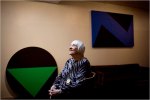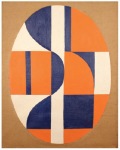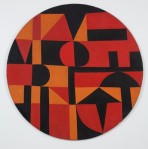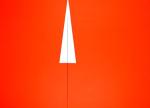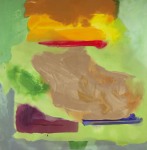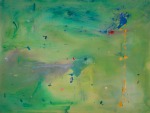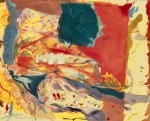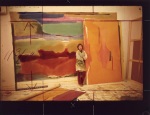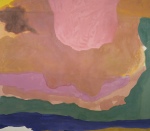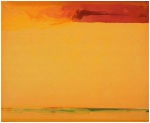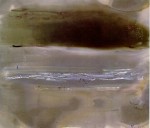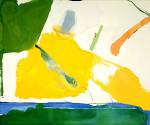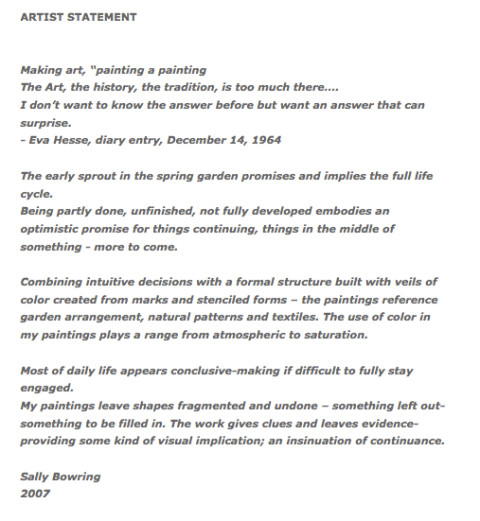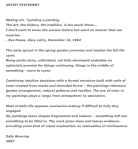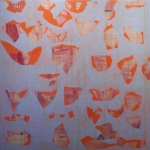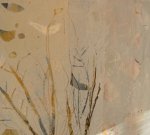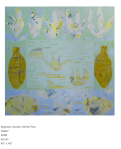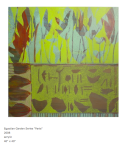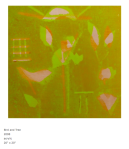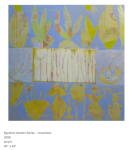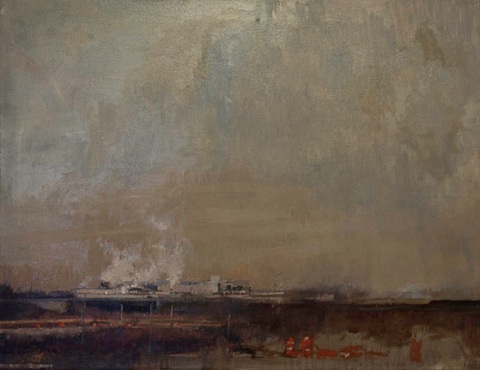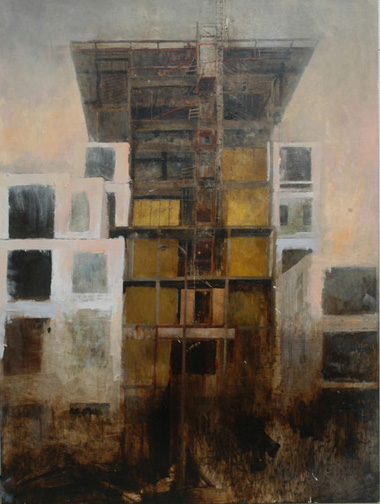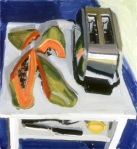“You don’t decide to be an artist, art gets inside of you..” -Carmen Herrera, 1915-
January 31, 2011 § Leave a comment
Carmen Herrera (born May 31, 1915) is a Cuban painter, born in Havana, who has lived in New York since the mid-1950s and has recently seen her work recognized in international circles. After six decades of private painting, she sold her first artwork in 2004 when she was 89 years old. A retrospective exhibition opened in July 2009 at the nonprofit IKON Gallery in Birmingham, England, and is traveling to the Pfalzgalerie Museum in Kaiserslautern, Germany from January 23rd to May 2nd 2010. London’s Tate Modern and the Hirshhorn Museum and Sculpture Garden in Washington, D.C. have recently acquired her works. -Wikipedia
Excerpts from a recent interview at The Guardian:
“When did you decide you were an artist?
You don’t decide to be an artist, art gets inside of you. Before you know it you’re painting, before you know it you’re an artist. You’re so surprised. It’s like falling in love.
Are you still learning now?
Yes, I am. I’m more dedicated to my art now and I’m more watchful. Anything – a piece of paper that’s folded in a funny way – I think, “ah, I can use that”. I feel much more aware now.”
Read the full interview at The Guardian.
Joanne Mattera Art Blog: Guaranteed Biased, Myopic, Incomplete and Journalistically Suspect
January 31, 2011 § Leave a comment
Have you ever wondered if being an artist is a legitimate career? Here’s a new link to bookmark, Joanne Mattera’s Art Blog: straight talk from an artist about the business side of art, among other things. A sample post….
“In a recent interview in The Guardian, the 95-year-old Cuban-born, New York City-based abstractionist Carmen Herrera–”discovered” at the age of 89–was asked what advice she would give her 20-year old self.
This is her answer: ‘Don’t hurry up, just take your 20s as long as you can. But the 20s is not an easy time. A lot of things are coming to you that you’re not ready to absorb. You have to get old and wrinkled and grey-haired before you know what they’re talking about.’
I don’t know about the “old and wrinkled and grey-haired,” but since I teach a course to art school seniors about to embark on their art careers, I often give to them the advice I wish someone had given me. Here’s what I would tell my 20-year-old self: ……….”
Continued on http://joannemattera.blogspot.com/
Paint and Process, Week 4: Helen Frankenthaler
January 30, 2011 § Leave a comment
Helen Frankenthaler is known for her large scale paintings made with poured paint on unstretched canvas, and her experimental manipulations of liquid paint using tools such as squeegees, housepaint brushes and sponges.
New Figure Exhibition at College of William and Mary
January 29, 2011 § Leave a comment
This came in from my friend Bill Barnes at William and Mary, an exhibition of contemporary figure painters of note. Lots of links to the individual artists.
http://www.wm.edu/as/andrewsgallery/currentexhibitions/index.php
Week 3: Paint and Process: Sally Bowring
January 27, 2011 § Leave a comment
Sally Bowring
is a painter who lives and works in Richmond, Virginia. She teaches painting at Virginia Commonwealth University. Her paintings come from her intense interest in, and observation of what’s around her: nature, her garden, the city, music, food, poetry, forms of all kinds. In one of her artist statements she references Aretha Franklin as a source of inspiration. Sally’s paintings appeal directly to our senses through their rich textures and color, and by their references to natural forms which emerge and disappear into the many layers of the painted surface. She sometimes uses masks and stencils to form windows, or openings, in the calm painted skins of her panels through which we can glimpse back into the layers and substrates of earlier, more kinetic stages in the painting and the vigorous mark-making that reveals the artist’s hand. Her color is “up-tempo,” optimistic in its ebullience and just pushing at the edge of acidic. Sally Bowring’s paintings are beautiful essays on the interchange between her meditations on the great givens of nature, and the intuitive flow of formal process. They are both image and object.
Shared Intelligence: American Painting and the Photograph
January 26, 2011 § Leave a comment
Exhibition at the Columbus Museum of Art, February 4 – April 24.
“Painting and photography have had a long relationship in American art. Since its invention, photography has influenced the way we see the world as much as how paintings have for centuries. Shared Intelligence explores the dynamic ways visual artists have been inspired by and used the photograph. The exhibition of more than 75 paintings and photographs focuses on the work of American painters for whom the photograph has been essential to the development of their work, such as Thomas Eakins, Frederic Remington, Charles Sheeler, Georgia O’Keeffe, Norman Rockwell, Andy Warhol, and contemporary artists, such as Robert Rauschenberg, Chuck Close, David Hockney, and Sherrie Levine. Major works by such ground-breaking photographers as Eadweard Muybridge, Alfred Stieglitz, Man Ray, Edward Weston, Walker Evans, and Margaret Bourke-White will also be included.”
http://www.columbusmuseum.org/exhibitions/future-exhibitions.php
Ryan Smith at Art Access Gallery, Columbus
January 21, 2011 § Leave a comment
Weekly Object Painting
January 18, 2011 § 1 Comment
“The day is coming when a single carrot, freshly observed, will set off a revolution.” – Cezanne
“With an apple I will astonish Paris.” – Cezanne
“Seeing is the initial act of valuing, and the nature and infinite potential of human beings to see and to aesthetically order the world is the one pure subject of art.” – Robert Irwin, “The Hidden Structures of Art,” 1993
Some inspirations to guide your studies:
Also, check out this page from painter Catherine Kehoe’s blog, Powers of Observation:
http://picasaweb.google.com/catherinekehoe8/SomeStillLifePaintings#
Week 1: Paint and Process
January 17, 2011 § 1 Comment
“Remember that a painting – before it is a battle horse, a nude model, or some anecdote – is essentially a flat surface covered with colours assembled in a certain order.” -Maurice Denis, 19th c. painter.
“The plastic arts, at their most perfect, must become music and move us by the immediacy of their sensuous presence.” -Schiller, 19th c. poet.
Maurice Denis’ statement above was a battle cry against the moribund academic painting of the 19th century, and a key to how this course is organized. One of the most popular salon painters of Denis’ time, William-Adolphe Bouguereau, said of Manet, “Manet doesn’t know how to finish a painting.” Manet’s retort was, “Bouguereau doesn’t know how to begin a painting.”
How do you begin a painting? What are you most aware of? How does your awareness move, shift, or splinter as you push the work along? How do you define your task at each stage as the painting develops? Are your thoughts dominated by the struggle to create a likeness, or by a desire to depict a particular subject matter? To what degree are you aware of the medium itself, its tactility or even its smell? What ideas come to you from the material itself in terms of how it can be manipulated?
When you look at paintings in museums or galleries you only see how they ended, not how they began. We begin the semester by looking at paint itself. Marshall McLuhan’s dictum: “The medium is the message,” is our motto. To impose a bit of structure on the problem -like the grain of sand around which the oyster spins the pearl – we borrow on the earliest roots of painting: the emblematic images of the paleolithic cave painters, a strategy that has been adopted by many contemporary artists. Paul Klee, Philip Guston, Jasper Johns, Jim Dine, Susan Rothenberg, Basquiat, Andrew Crane, Vivienne Voorland, and Jayne Johnson are pictured here along with comparisons to their prehistoric ancestors. Despite the sophistication gained in the intervening millenia, there is still something in painting that remains of the ritual magic of its origins.
- Paleolithic Rock Painting
- Susan Rothenberg
- Paleolithic Petroglyphs
- Paleolithic Rock Painting
- Paleolithic Rock Painting
- Jean Dubuffet
- Paleolithic Rock Painting
- Susan Rothenberg
- Susan Rothenberg
- Paleolithic Rock Painting, Rock Circle at Exeter Hill
- Jasper Johns
- Philip Guston
- Jim Dine
- Jim Dine
- Jim Dine
- Jean-Michel Basquiat
- Andrew Crane
- Vivienne Voorland
- Jayne Johnson
- Jayne Johnson
Matisse’s Advice to Young Painters
January 15, 2011 § Leave a comment
“A young painter should realize that he does not have to invent everything, but that he should above all get things straight in his mind by reconciling the different points of view expressed in the beautiful works by which he is affected, and at the same time by directly questioning nature. After he has become acquainted with his means of expression, the painter should ask himself, ‘What do I want?’ and proceed in his researches, both simple and complex, to try to find it. If he can preserve his sincerity toward his deeper sentiment without trickery or without being too lenient with himself, his curiosity will not desert him and he will therefore have in his old age the same ardour for hard work and the necessity to learn that he had when young. What could be better!”
From Matisse on Art, by Jack Flam
Carmelina, by Henri Matisse Henri Matisse, by Andre Derain
